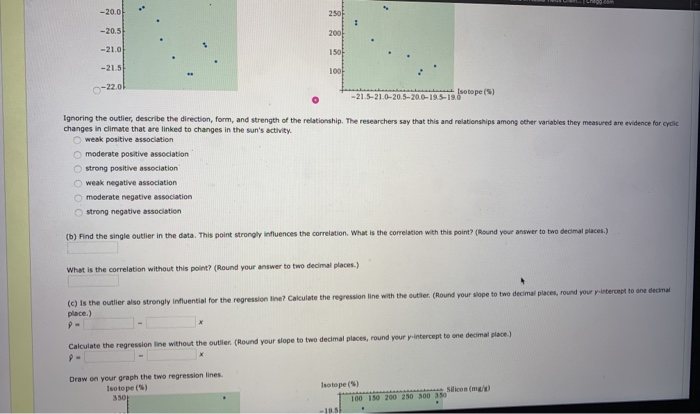ASK YOUR TEACHER Drilling down beneath a lake in Alaska yields chemical evidence of past changes in climate Biological silicon, left by the skeletons of single-celled creatures called diatoms, measures the abundance of ife in the lake. A rather complex variable based on the ratio of certain isotopes relative to ocean water gives an indirect measure of moisture, mostly from snow. As we drill down, we look farther into the past. Here are data from 2300 to 12,000 years ago Isotope Silicon Isotope Silicon Isotope Silicon (9%) (mg/9) (mg/9) (9) (mg/g) -19.90 97 -20.71 152 -21.63 - 19.84 105 -20.80 267 -21.63 233 - 19.46 118 -20.86 271 -21.19 184 -20.20 143 -21.28 298 -19.37 339 (a) Make a scatterplot of silicon (response) against isotope (explanatory). Sicon (m) Isotope (S) Isotope (S) 400 100 150 200 250 300 350 -19.5 350 300 -20.0 250 1 -20.5 200 -21.01 150 -215 100 Slicon (mg/) -21.5-21.0-205-200-19.5-18.00 Slicon (mg/l) 350 Isotope (9) Silicon (mg/) 100 150 200 250 300 350 - 19.51 300F 250 -20.0 -20.5 2001 10 150 - 20.0 2501 -20.5 2001 -21.0 1504 -21.5) 0-22.01 1001 ...sotope (5) -21.5-21.0-20.5-20.0-19.5-19.6 Ignoring the outlier, describe the direction, form, and strength of the relationship. The researchers say that this and relationships among other variables they measured are evidence forcycle changes in climate that are linked to changes in the sun's activity weak positive association moderate positive association strong positive association weak negative association moderate negative association strong negative association (b) Find the single outlier in the data. This point strongly influences the correlation. What is the correlation with this point? (Round your answer to two decimal places.) What is the correlation without this point? (Round your answer to two decimal places.) () is the outler also strongly influential for the regression line? Calculate the regression line with the outlet. (Round your slope to two decimal places, round your intercept to one decim place.) Calculate the regression line without the outler (Round your slope to two decimal places, round your intercept to one decimal place) 9 - Draw on your graph the two regression lines. Isotope() 350 Isotope (5) Silicon (mg 100 150 200 250 300 350 -185 Calculate the regression line without the outler (Round your slope to two decimal places, round your y-intercept to one decimal place) 9- Draw on your graph the two regression lines. Isotope (S) 3501 Isotope (5) Silicon (mg/l) 100 150 200 250 300 350 - 19.5 300 250 -200 200 150 -210 100 -21.5 Slicon (mg/) -21.5-21.0-20 5-20.0-19.5-10.0 -2201 Silicon (mg/) 350 Silicon (mg/) Isotope (S) 100 150 200 250 300 3.50 - 19.5 300 -20.01 200 - 20:51 150 -21.01 100 -21.5 -213-218-20-200-135-15 Lotope (5) But wwer ASK YOUR TEACHER Drilling down beneath a lake in Alaska yields chemical evidence of past changes in climate Biological silicon, left by the skeletons of single-celled creatures called diatoms, measures the abundance of ife in the lake. A rather complex variable based on the ratio of certain isotopes relative to ocean water gives an indirect measure of moisture, mostly from snow. As we drill down, we look farther into the past. Here are data from 2300 to 12,000 years ago Isotope Silicon Isotope Silicon Isotope Silicon (9%) (mg/9) (mg/9) (9) (mg/g) -19.90 97 -20.71 152 -21.63 - 19.84 105 -20.80 267 -21.63 233 - 19.46 118 -20.86 271 -21.19 184 -20.20 143 -21.28 298 -19.37 339 (a) Make a scatterplot of silicon (response) against isotope (explanatory). Sicon (m) Isotope (S) Isotope (S) 400 100 150 200 250 300 350 -19.5 350 300 -20.0 250 1 -20.5 200 -21.01 150 -215 100 Slicon (mg/) -21.5-21.0-205-200-19.5-18.00 Slicon (mg/l) 350 Isotope (9) Silicon (mg/) 100 150 200 250 300 350 - 19.51 300F 250 -20.0 -20.5 2001 10 150 - 20.0 2501 -20.5 2001 -21.0 1504 -21.5) 0-22.01 1001 ...sotope (5) -21.5-21.0-20.5-20.0-19.5-19.6 Ignoring the outlier, describe the direction, form, and strength of the relationship. The researchers say that this and relationships among other variables they measured are evidence forcycle changes in climate that are linked to changes in the sun's activity weak positive association moderate positive association strong positive association weak negative association moderate negative association strong negative association (b) Find the single outlier in the data. This point strongly influences the correlation. What is the correlation with this point? (Round your answer to two decimal places.) What is the correlation without this point? (Round your answer to two decimal places.) () is the outler also strongly influential for the regression line? Calculate the regression line with the outlet. (Round your slope to two decimal places, round your intercept to one decim place.) Calculate the regression line without the outler (Round your slope to two decimal places, round your intercept to one decimal place) 9 - Draw on your graph the two regression lines. Isotope() 350 Isotope (5) Silicon (mg 100 150 200 250 300 350 -185 Calculate the regression line without the outler (Round your slope to two decimal places, round your y-intercept to one decimal place) 9- Draw on your graph the two regression lines. Isotope (S) 3501 Isotope (5) Silicon (mg/l) 100 150 200 250 300 350 - 19.5 300 250 -200 200 150 -210 100 -21.5 Slicon (mg/) -21.5-21.0-20 5-20.0-19.5-10.0 -2201 Silicon (mg/) 350 Silicon (mg/) Isotope (S) 100 150 200 250 300 3.50 - 19.5 300 -20.01 200 - 20:51 150 -21.01 100 -21.5 -213-218-20-200-135-15 Lotope (5) But wwer









